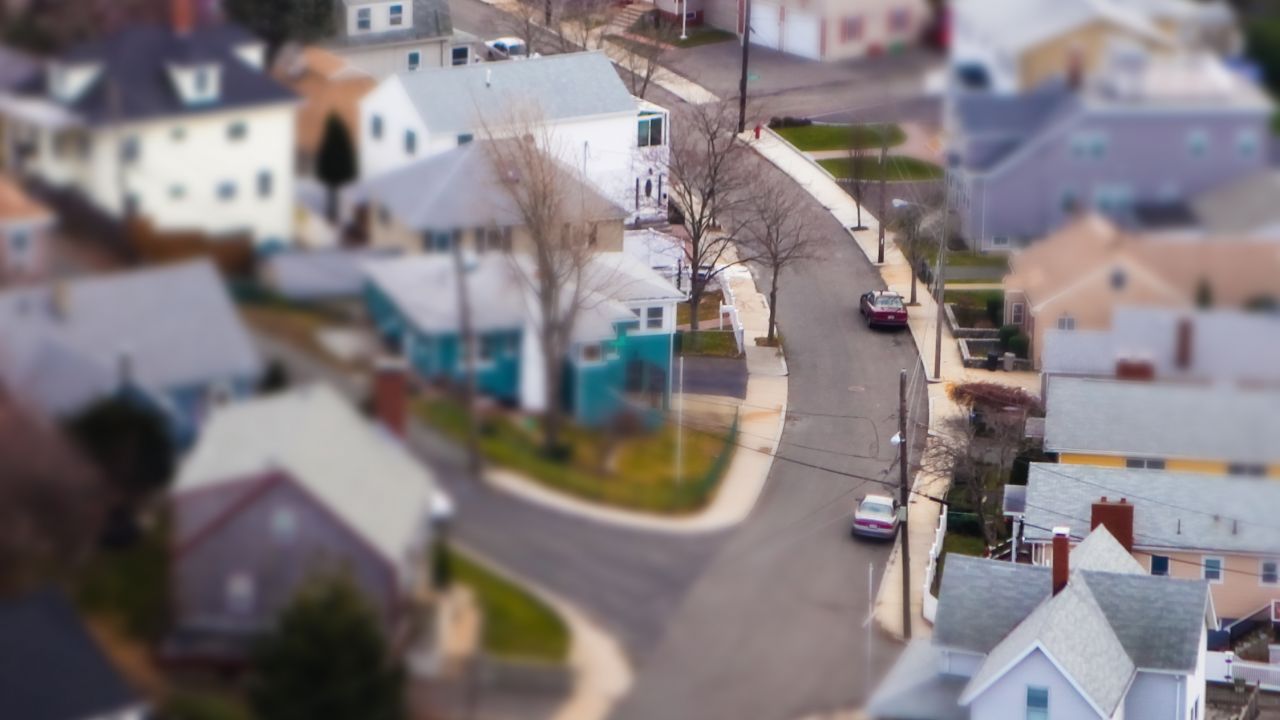
A Boston suburb from the air. (Photo by Aftab Uzzaman | Flickr CC 2.0)
Editor’s Note
Economic inequality in the United States may seem inevitable, but it’s not. As we’ve documented on this website many times, the distribution of wealth in the United States has become increasingly concentrated as a result of government policies that began in the Reagan era. According to the Center on Budget and Policy Priorities, the best survey data show that in the 21st century, “the top 3 percent of the distribution hold over half of all wealth.”
One of the ways in which wealth is redistributed upwards to the wealthiest among us today is via the mortgage interest deduction, a point illustrated by sociologist Matthew Desmond in a New York Times Magazine piece earlier this month.
In a new book entitled Toxic Inequality: How America’s Wealth Gap Destroys Mobility, Deepens the Racial Divide, & Threatens Our Future, sociologist Thomas Shapiro digs more deeply into the issue from the perspective of that other yawning gap in American society today: the racial wealth gap. Shapiro explains that the mortgage interest deduction, while the biggest driver of economic inequality, is not the only one baked into our tax code. He outlines how retirement savings and health insurance tax deductions also favor high earners, who are predominantly white Americans.
In this book excerpt and video interview, Shapiro reveals how the commonly held assumption that the poor receive the most subsidies from the government is a mistaken one and explains how tax deductions help some families build wealth while others continue to struggle in poverty.
If asked to describe American housing policy, the average person would almost surely answer that the government spends massive amounts of money on public and subsidized housing for poor and low-income families.
Yet this is not the case.
Federal housing programs began in the 1930s with public housing developments owned and operated by the government. Over time, these original efforts have been joined by a large number of other programs that subsidize privately built and operated housing developments and provide housing vouchers for tenants to live in private units of their own choosing. In all, we devote about $40 billion a year to means-tested housing programs for low-income and homeless families.1 By contrast, in 2015, the public invested $205.6 billion in home ownership. Over the six years from 2012 to 2017, $1.2 trillion will have been dedicated to subsidize home ownership, mostly through the mortgage interest tax deduction that permits home owners to deduct from their tax liability the interest paid on their mortgages.2 We invest five times more public money in home ownership for families that can afford homes than in decent, affordable housing for those who cannot.
Furthermore, this public investment in home ownership flows mostly to the best-off home owners, redistributing wealth at the top, driving wealth inequality, and contributing to toxic inequality. One set of estimates calculated that the top 10 percent of taxpayers reaped 86 percent of the total distributed through the mortgage interest deduction.3 The Tax Policy Center’s model calculated that the top 20 percent of taxpayers reaped 72 percent of the annual subsidy. Either way, the inescapable fact is that the best-off benefit at the expense of the majority. Indeed, a family in the top 1 percent of income earners receives an average $6,116 subsidy from the mortgage interest deduction, while a middle-income home owner like Reese Otis receives a modest $183 on average. Adding in federal tax deductions claimed for state and local property taxes swells the average public subsidy among the top 1 percent to over $10,000.
Meanwhile, many home owners are excluded from the subsidy entirely. The Medinas were one such family, and they owed more on the home than they could sell it for. As they approached retirement, their home was the largest single asset they controlled, critical both for shelter and for their economic security. Arguably, they were ideal candidates for the public good of housing stability. But collecting $62,000 per year from paychecks, they were not poor enough to qualify for housing assistance. And not a dollar of the over $200 billion in home ownership subsidies delivered each year through the tax code reaches them either. Taking the mortgage interest deduction would require the Medinas to itemize deductions, and their mortgage interest payments and other deductions were not greater than the $12,600 standard deduction for a family. Only 35 percent of those in their tax bracket itemize deductions. If HUD paid out the mortgage interest deduction, then the Medinas might qualify for both it and the standard deduction. Home ownership subsidies delivered through the tax code are simply not designed for moderate-income families like theirs.4
Unlike the Medinas, 2 of every 3 filers with $75,000 or more in income itemized their tax returns in 2014.5 This is one of several reasons that housing subsidies flow to high-income, least-in-need home owners. Not only are high-income families far more likely to itemize deductions on their taxes, but home ownership deductions are also pegged to the family’s tax bracket, with deductions being worth more in the higher tax brackets. With the same mortgage amounts, this means that someone with $150,000 in income in the 28 percent tax bracket could get a bigger deduction than someone with $80,000 in income in the 25 percent tax bracket. Taxpayers can deduct the interest paid on first and second mortgages up to $1 million in mortgage debt (the limit is $500,000 if married and filing separately). Any interest paid on first or second mortgages over this amount is not tax deductible. Furthermore, high-income families buy more expensive homes, taking out bigger mortgages and thus paying more interest eligible for tax deduction. In addition, the first $500,000 (for a couple) gained from selling a primary residence is exempted from taxation, and gains over that amount are subject to the 14 percent capital gains tax rate. And families in high-income tax brackets, say 33 percent ($230,000 to $412,000 for a couple), benefit most from capital gains exclusions because the tax liability from profit in excess of $500,000 from home sales is thus 19 percent lower than the tax liability if it were income.
The mortgage interest deduction is just one mechanism through which public investment flows to the wealthy at tax time. Another relates to the tax code’s treatment of retirement savings. Earlier, we met the Ackerman family, whose largest reservoir of wealth is an employer-sponsored retirement savings plan with matching benefits. When we interviewed her, we learned that Allison Ackerman contributed $3,000 annually to the retirement account, and her employer added another $5,100. All of this money — treated as pretax and not reported as income until she retires and begins drawing from the account — was shielded from tax liability. Assuming the family was in the 25 percent tax bracket, this retirement package amounted to a $2,025 tax subsidy. If Allison had not had access to her employer-sponsored account and invested the same $3,000, the Ackermans’ actual income taxes would increase by about $750 and thus reduce her after-tax paycheck. The tax-shielded status of these contributions should be seen as a public investment producing private wealth, no different from the expenditures that flow toward home owners. It has enabled the Ackermans to feel comfortable and helped them over their working years to build a retirement nest egg of $350,000.
This public investment is not nearly as undemocratic as the incentives benefitting wealthy home owners. Inclusive, employer-sponsored, mandatory and matched savings vehicles for retirement indeed ought to be encouraged by government policy and supported with public resources, for they can help move typical American families forward and bolster economic security. The problem, again, is that right now the supporting mechanism of saving for retirement with pretax money, a problem magnified if matching money is involved, mostly benefits those working at large organizations, and, as we have seen, minorities, women, immigrants, and low-paid workers are less likely to find jobs with such employers. All told, federal tax subsidies for retirement benefits will rise to $180 billion in 2016. And as with the mortgage interest deduction, over two-thirds (68 percent) of that amount accrues to the top one-fifth of earners. The top 10 percent get over half (51 percent) of the tax subsidies for employer-based retirement account payments. This translates to an average $12,000 entitlement for the top 1 percent of earners and $363 for a family in the middle.6 As a result, the distribution of public benefits still tilts in a distorted fashion to the top and most often to whites.
A similar mechanism and off-kilter distribution applies to health insurance. When workers participate in an employer-sponsored health insurance plan, their pretax contribution to the cost of coverage is not tax liable. This public investment, intended to encourage broader health care coverage, cost taxpayers $155 billion in 2016, not including revenue lost to Social Security.7 When an employer pays for part or all of a worker’s coverage, that benefit is not counted as income, and there is no cap on how large it can be. The Patient Protection and Affordable Care Act (commonly called the Affordable Care Act or, colloquially, Obamacare) included a provision that will recover public revenues on very high-cost plans starting in 2018. Workers whose employers provide health insurance — typically those who work at large companies or organizations, like the Ackermans — receive the added benefit of paying for health insurance with pretax money. Roughly 160 million Americans get their health insurance through their employers. In 2014, 8 million tax filers claimed medical deductions, and filers with incomes over $100,000 received 62 percent of the total benefit, making the distributional impact somewhat less tilted to the very wealthy.8
The data are abundantly clear that tax expenditures actively redistribute wealth to the top while skipping those low- and moderate-income families most in need of building up assets. However, because race and ethnicity data are not collected on tax forms, we have less direct information about the racial distribution of tax expenditures or their impact on the racial wealth gap. But research clearly suggests this impact is substantial. In one study, the Tax Policy Center examined ZIP codes in which high rates of residents claimed the mortgage interest deduction. It found that African-Americans represent only 5.6 percent of the population in these areas, less than half their national proportion.9 Residents of ZIP codes with the highest rates of taxpayers claiming the deduction — where big federal dollars flow to subsidize home ownership — are disproportionately white, middle-aged and married. Another way of getting a handle on the nexus of race and tax expenditures is to analyze expenditures by income brackets, since we know the exact percentage of African-Americans in each income bracket. This blunt method shows that African-Americans receive only 3.5 percent of public investments via tax expenditures in individual wealth building, when they comprise 13.2 percent of the population. Using the 2014 estimate10 that wealth-building tax expenditures total nearly $400 billion annually, this means that the tax code delivers a whopping $35 billion discriminatory race penalty each year. African-American families would accumulate $35 billion more in wealth each year if their incomes were distributed according to their national representation — 13.2 percent in each income bracket. Projecting that one-year figure out to the Tax Policy Center’s six-year estimate of $2.5 trillion in public investment in home ownership, retirement security, small business development, and other areas via tax expenditures suggests a massive structural race deficit.11 The African-American share of this investment falls over $200 billion short of African-Americans’ demographic representation. This is a clear case of policy shutting the door to wealth for African-Americans and other people of color.
Excerpted from Toxic Inequality: How America’s Wealth Gap Destroys Mobility, Deepens the Racial Divide, & Threatens Our Future by Thomas M. Shapiro. Copyright 2017. Available from Basic Books, an imprint of Perseus Books, LLC, a subsidiary of Hachette Book Group.
1. Robert Collinson, Ingrid G. Ellen, and Jens Ludwig, “Low- Income Housing Policy,” National Bureau of Economic Research, Working Paper No. 21071, April 2015. ↩
2. Benjamin Harris et al., “Tax Subsidies for Asset Development: An Overview and Distribution Analysis,” Urban Institute, March 7, 2014. ↩
3. Adam J. Cole, Geoffrey Gee, and Nicholas Turner, “The Distributional and Revenue Consequences of Reforming the Mortgage Interest Deduction,” National Tax Journal 64, no. 4 (2011): 977–1000. ↩
4. Other perverse incentives in the current mortgage interest deduction include front-ending allowable interest deductions, creating a tax incentive to sell homes more quickly. ↩
5. Staff of the Joint Committee on Taxation, “Estimates of Federal Tax.” ↩
6. Harris et al., “Tax Subsidies.” ↩
7. Staff of the Joint Committee on Taxation, “Estimates of Federal Tax.” ↩
8. Ibid. ↩
9. Benjamin Harris and Lucie Parker, “The Mortgage Interest Deduction Across ZIP Codes,” Urban-Brookings Tax Policy Center, Dec. 4, 2014. ↩
10 Harris et al., “Tax Subsidies.” ↩
11. Ibid. ↩




